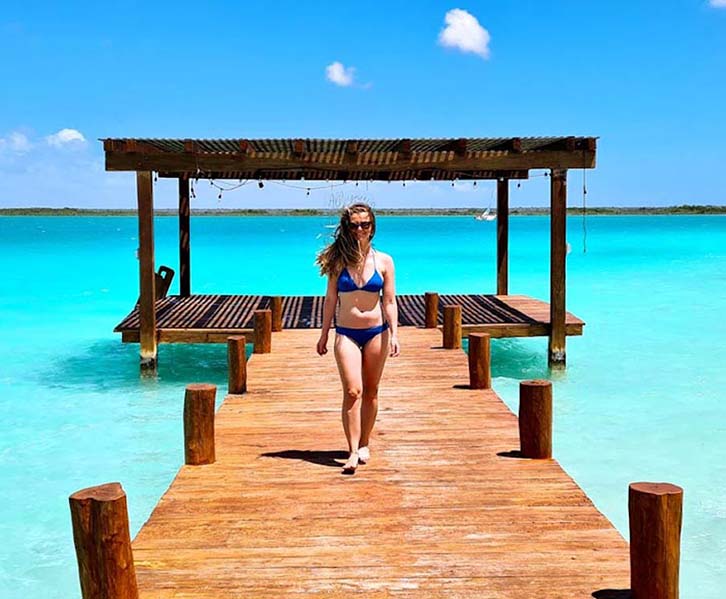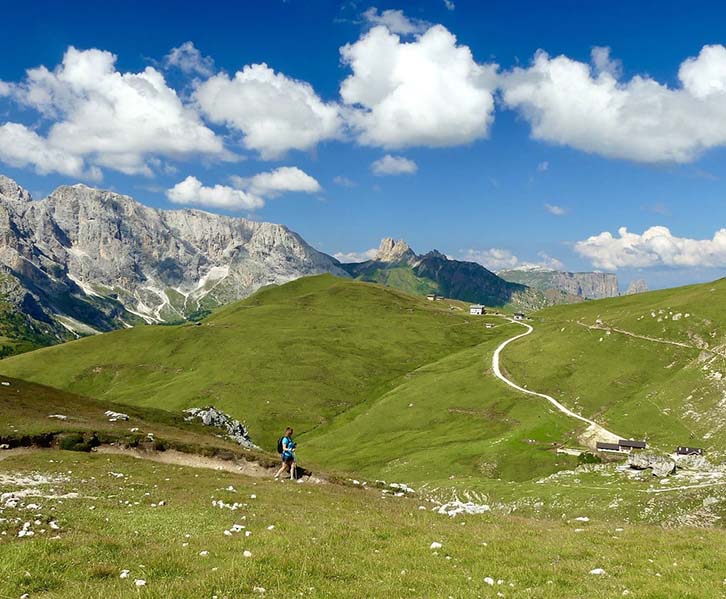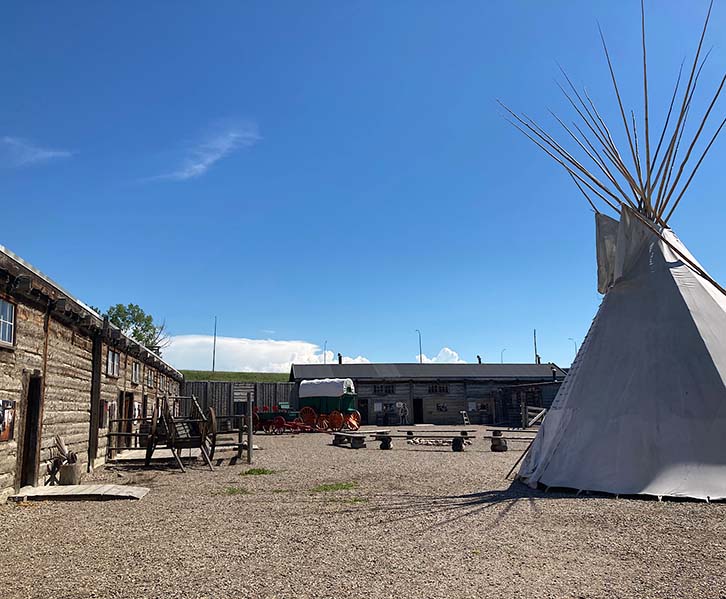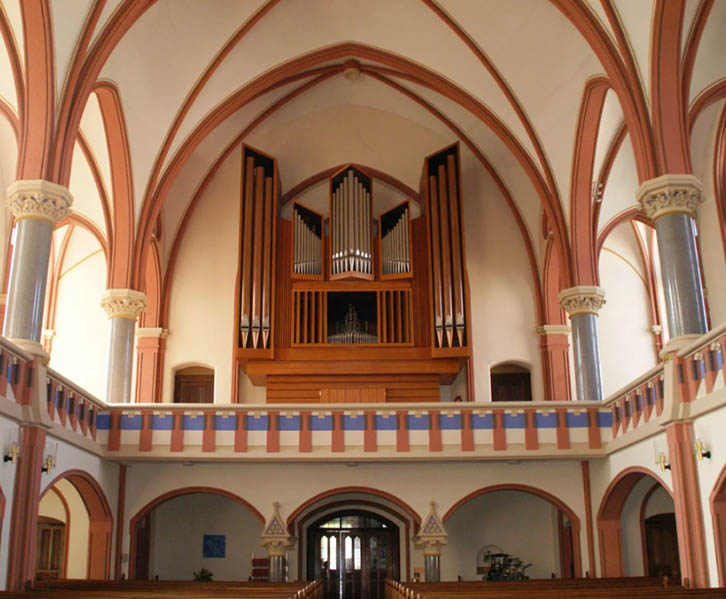Bacalar Lagoon is a massive freshwater lake, approximately 42 kilometers long and only 2 kilometers at its widest point. It is fed by underwater cenotes, and the water is typically a vibrant Caribbean blue, with deeper shades in the crevices, earning it the nickname “Seven-Color Lake.”
The town of Bacalar is located on the southwestern shore of the lagoon and is a small, sleepy place. The town center is adorned with colorful murals, some excellent restaurants, and a few lively bars. When I first visited, Bacalar was still quite off the beaten path. Nowadays, its popularity has noticeably increased, with trendy new bars and restaurants springing up like mushrooms. However, it remains tranquil and laid-back as ever.
Taking a Boat Tour of Bacalar Lagoon
One of the most popular activities in Bacalar is taking a boat tour of the lagoon. I enjoyed it so much that I did the same trip both times I visited Bacalar.

The classic option is to take a 2-hour tour on a lancha (small boat) or pontoon. You’ll visit all the main attractions of Bacalar Lagoon, including the “Pirate Canal,” the layered stone conservation area, and the underwater cenotes that supply the lake with water. It’s a great way to observe the significant differences in water color in various parts of the lake.
You’ll find many different tour companies in Bacalar, all offering very similar boat tours. The prices are fixed, so each company offers the same rates. The pontoon tour costs 400 Mexican Pesos per person, while the lancha tour is priced at 300 Mexican Pesos per person.
You can also book private tours, sailboat excursions, and catamaran cruises.
Bacalar Sightseeing Cruise (including open bar and snacks), starting at $48 USD
Laguna de Bacalar Pontoon Tour, as low as $22.84 USD
Lake Navigation Tour, starting at $42 USD
Private Catamaran Sailing Tour, from $227.86 USD
Small Group Guided Sailboat Tour, $45.11 USD
Swimming in Cenote Azul
Cenotes are natural, water-filled sinkholes where the tops of limestone caves have collapsed. Some are located beneath Bacalar Lagoon, while Cenote Azul is situated on the lakeshore, separated from the emerald waters of the lake by a small piece of land.
Cenote Azul is nearly 300 feet deep and boasts a deep blue hue that contrasts vividly with the nearby lake. Swimming in this deep blue pool is a marvelous experience, and it’s a must-do when you visit Bacalar.
Cenote Azul is approximately a 10-minute drive (or a 50-minute walk) from Bacalar town. The cost of taking a taxi there should not exceed 60 Mexican pesos. There is an entrance fee of 25 Mexican pesos to visit Cenote Azul. Inside, you’ll find a restaurant, restrooms, and several fantastic swings over the water, some of which are Instagram-worthy.
If you want to explore its depths, you can also go scuba diving in Cenote Azul! Dive centers near Mahahual can organize this activity.
Explore the stromatolites
Bacalar boasts a highly unique natural phenomenon: stromatolites. They are, in fact, living fossils with a history dating back approximately 3.5 billion years, making them the oldest life forms on our planet. Moreover, they have been found in only a few places worldwide!
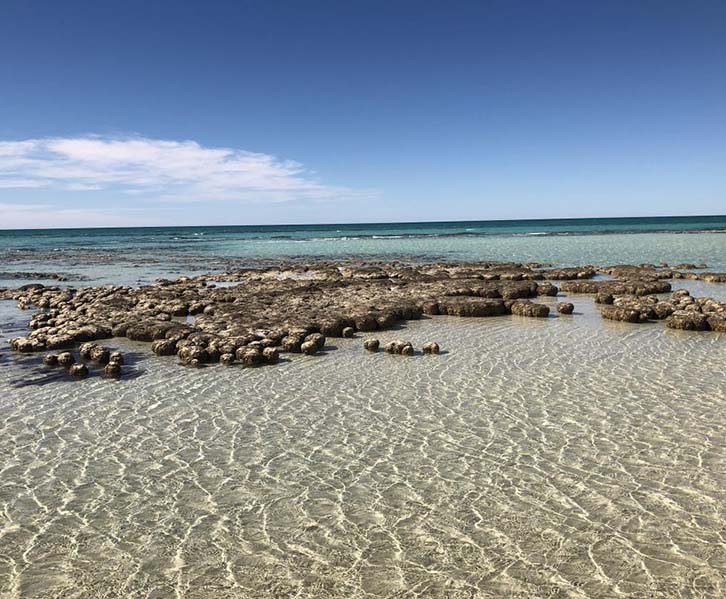
So, what are stromatolites? Essentially, they are stone structures built by microorganisms called cyanobacteria from sediment. Stromatolites sequester elements like carbon dioxide and actively contribute to improving the environment, and they are believed to be one of the reasons for the exceptionally clear waters of the lake.
These living fossils are visible all around the lake. There’s a stromatolite preservation area in front of Cocolitos baleario, several stromatolite preservation areas in front of Beach Club Blu, and the famous stromatolite strait known as Los Rapidos.
When you witness these stromatolites in Bacalar, please help protect them! Absolutely do not touch or stand on them, as this could cause irreversible damage. You should also avoid applying sunscreen in the lake (even if it’s reef-safe sunscreen): I recommend wearing a rash guard.
Explore local history at San Felipe Fort
San Felipe Fort stands in the heart of Bacalar. Built in 1733, it was constructed to protect the town from multiple pirate attacks and has a very interesting history.
Pirates would sail up the Hondo River, through the surrounding marshes of Bacalar to attack the town. These were not the lovable rogues from Hollywood movies but rather ruthless criminals, and their attacks on the town were devastating – hence the need for a full-fledged military fortress. Perched atop a hill, the San Felipe Fort offers breathtaking views of the lagoon, making it a spectacular sight!
Inside the fortress, there is a small museum that outlines the history of Bacalar and delves further into the stories of pirates. The entrance fee for foreign tourists is 110 Mexican pesos (55 Mexican pesos for locals) – although if you visit later in the day, the ticket seller might only charge you half price.
Explore Downtown Bacalar
San Felipe Fort stands in the heart of Bacalar. Built in 1733, it was constructed to protect the town from multiple pirate attacks and has a very interesting history.
Pirates would sail up the Hondo River, through the surrounding marshes of Bacalar to attack the town. These were not the lovable rogues from Hollywood movies but rather ruthless criminals, and their attacks on the town were devastating – hence the need for a full-fledged military fortress. Perched atop a hill, the San Felipe Fort offers breathtaking views of the lagoon, making it a spectacular sight!
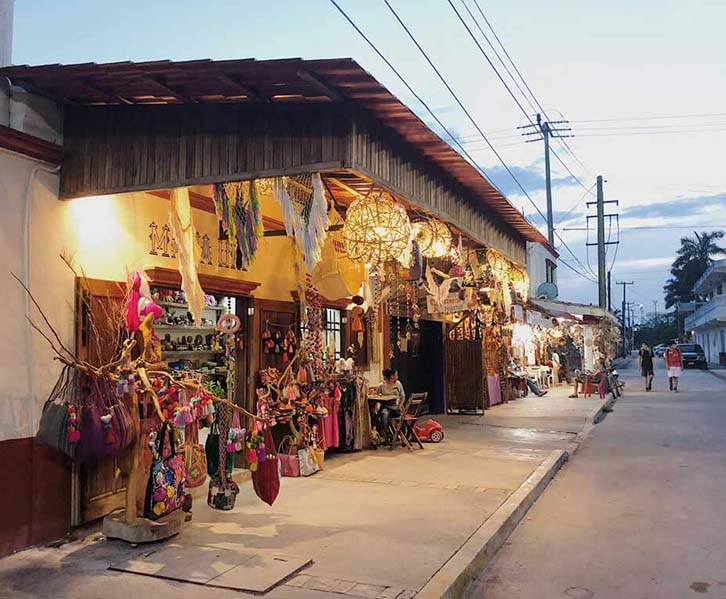
Inside the fortress, there is a small museum that outlines the history of Bacalar and delves further into the stories of pirates. The entrance fee for foreign tourists is 110 Mexican pesos (55 Mexican pesos for locals) – although if you visit later in the day, the ticket seller might only charge you half price.
Just wander around and see what you discover – be sure to explore these main attractions…
- Bacalar Sign – The colorful sign in front of the Zocalo, right next to San Felipe Fort.
- Zocalo – The central square with a beautiful park and several great cafes, restaurants, and bars surrounding it. At sunset, hundreds of noisy birds descend on the trees in the park.
- Parroquia de San Joaquin – A lovely 19th-century church dedicated to the town’s patron saint.
- San Felipe Fort
Admire all the street art murals
One of the reasons I love Bacalar is its abundant street art. In the neighborhoods around the Zocalo (central square), it’s hard to find a street without at least one stunning mural.
Float on the natural lazy river at Los Rapidos
Although I’ve been to Bacalar multiple times, I’ve never been to Los Rapidos. This is just another reason to return to the stunning lagoon, as it’s one of the must-do activities in Bacalar.
Los Rapidos is a narrow, mangrove-surrounded section of Bacalar Lake that forms a canal with a natural “drift river.” You can walk to the far end and then float back along the channel with the current!
The sides of the channel are lined with stromatolites, making it a great place for close-up snorkeling to observe these “living fossils.” Just please don’t touch or walk on them!
Los Rapidos has a beach club and restaurant that requires an entrance fee. However, you can easily spend a whole day exploring: rent a snorkel, spend some time drifting along the channel. They also rent kayaks and paddleboards to enjoy the lake.
Relax at Bacalar Beach Club
One of my favorite things to do in Bacalar is to relax and enjoy the lake. Swimming, sunbathing, strolling… every few minutes, interrupt your silence and marvel at how blue the water is!
Around Bacalar Lagoon, there are actually no traditional sandy beaches, at least not like coastal areas.
Instead, there are many beach clubs or lakeside clubs. These are lakeside establishments, typically featuring a bar and/or restaurant, along with a few chairs or sunbeds. Some of them also offer changing rooms and towel rental services.
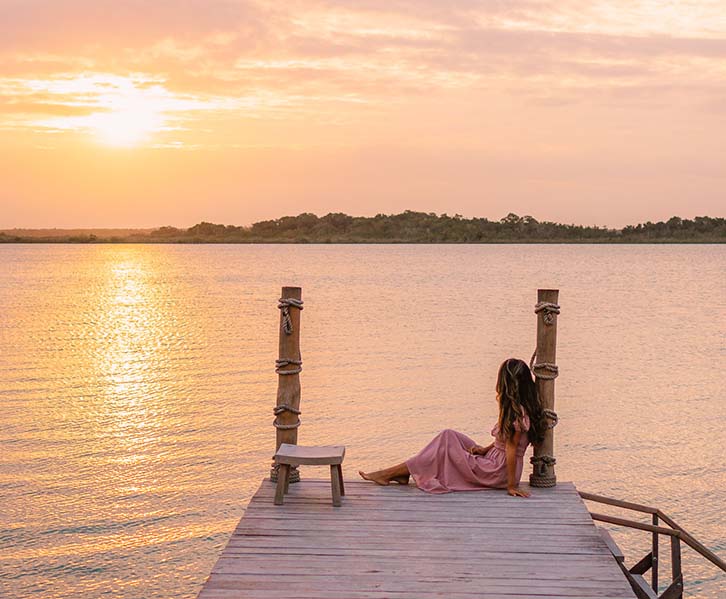
Many of the piers have small docks leading into the lake, so you can jump directly into deeper waters without wading through the powdery mud along the shore. There are plenty to choose from, so here are some of the most popular beach clubs in Bacalar…
- Beach Club Blu (my personal favorite) – Located just outside the town, near Cenote Azul, this is a super cool beach club with wonderful music and dreamy lake views. It feels a bit secluded and peaceful compared to beach clubs closer to the town.
- La Playita – Delicious food, a great atmosphere, and a long dock for swimming. This restaurant doesn’t seem to have a minimum consumption or entrance fee; as long as you dine at the restaurant, they seem happy to let you stay and swim!
- Bacalar Beach Club – A stylish spot close to the town, featuring a swimming pool, bar, and a deck area with sun loungers.
- Cenote Cocolitos – Perhaps the most famous beach club, but it was closed as of February 2023.
- Los Aluxes – Water hammocks, swings, and picturesque docks.
- Balneario Ejidal – One of the more affordable and rustic beach clubs, but very family-friendly as it has a waterslide that goes into the lagoon!
Paddleboarding or kayaking on the lake
During my first trip to Bacalar, I spent several afternoons kayaking and exploring the lake. I rented one from my hotel and had an especially memorable day paddling with my giant inflatable swan trailing behind me!
You can rent kayaks and paddleboards from many places around the lake, including various beach clubs, or you can participate in one of the fantastic tours listed below. It’s a great way to explore at a leisurely pace, and Bacalar’s waters are relatively calm, making it an easy place for paddling.
- Sunrise Paddleboard Tour and Floating Picnic (starting at $32 USD)
- Full-Day Kayak Rental in Bacalar (starting at $22 USD)
- Paddle at Sunrise with the Adventure Lab! (starting at $35.28 USD)
Explore the Kohunlich Maya Ruins
Chichen Itza may get all the glory, but the Yucatan Peninsula has more Maya and pre-Spanish ruins to explore. One of them is Kohunlich, which is quite close to Bacalar, making it a fantastic day trip option.
The site covers 21 acres and is surrounded by dense tropical jungle, creating a very cool adventure atmosphere. One of the most impressive structures is the Mask Temple, a pyramid dating back to around 500 AD, with enormous stucco masks on either side of the central staircase.
